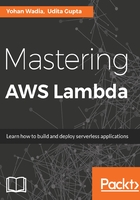
Introducing AWS Lambda
So, here we are, finally to the fun part! In this section, we will learn what Lambda is actually all about, what some of its salient features are, how it works and some steps on getting started with your very first Lambda invocation.
AWS Lambda was first introduced way back in 2014, at the yearly AWS re:Invent conference in Las Vegas. The idea back then, and which pretty much holds true even today, is that Lambda is a simple compute service that runs your code in response to certain events. These events can be anything, from an upload operation of an object to an S3 bucket, a record insertion in a DynamoDB table, or even some form of event triggered from your mobile app. The idea here is simple--you simply provide your code to AWS Lambda. Lambda will internally take care of provisioning and managing the underlying infrastructure resources, making sure your code gets deployed successfully; even things like your code's scalability and high availability are taken care of by Lambda itself! Now, that's neat!

Lambda was specially introduced by AWS to answer a very particular issue with EC2. Although EC2 still remains one of the most widely used core AWS services, it's still not designed to handle or respond to events; something that is required more often than not in today's applications. For example, a simple image upload activity to an S3 bucket triggers some form of operation, such as checking whether the object is actually a valid image, or whether it contains any viruses or unwanted malware. You can even have a requirement to create thumbnails of the uploaded image and put that up on your website. Now, imagine an EC2 instance doing all these activities for you. Firstly, you would have to program some mechanism for S3 to notify your EC2 instances to periodically perform checks on your S3 bucket, as EC2 has no way of telling when a new object has been uploaded.
Then again, you would have to manage the EC2 instance and handle all failovers, such as what happens if the EC2 instance fails to poll the S3 bucket, or what happens if the EC2 instance gets terminated for some reason. There's also the issue of scalability, right? Today you may be uploading just about 30-40 odd images, enough for a single EC2 instance to work on; but what happens when there is a large surge of upload operations? Will your EC2 instances scale effectively? And most important of all and by far the biggest issue for most enterprises--cost. Your EC2 instance will be running even on those days when there are no upload operations occurring in your S3 bucket. Sure there are many ways in which we can create workarounds for this, such as by creating a separate instance that polls continuously and by leveraging SQS or SNS as well, but isn't all that really overkill for something so simple? That's exactly the reason why Lambda is so popular and so widely used today. It just makes things simple!